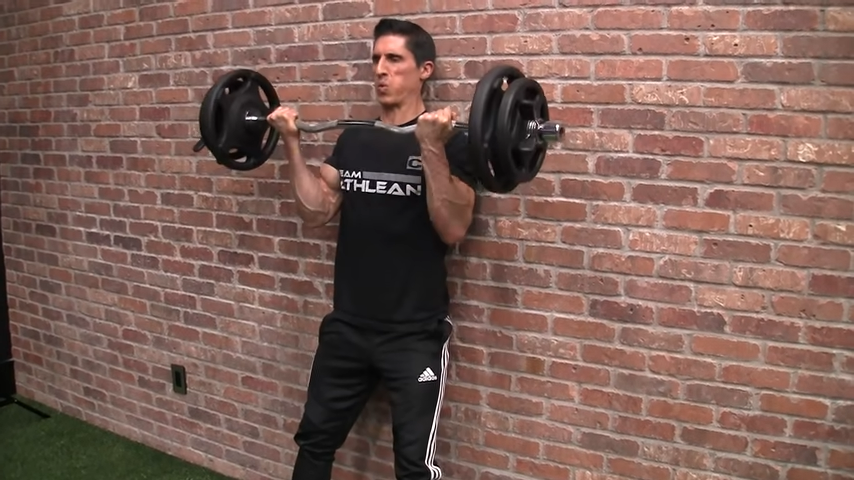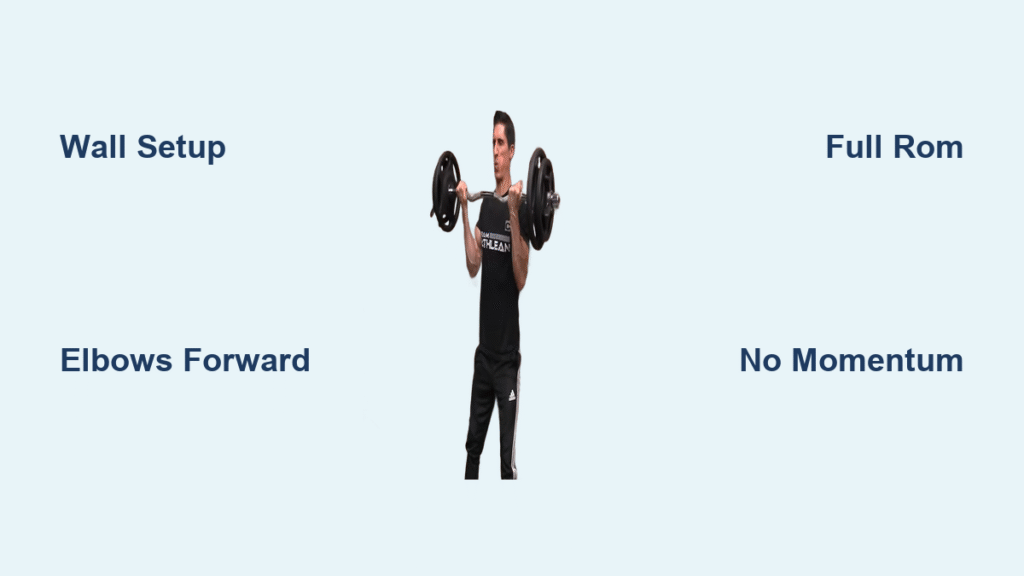That satisfying biceps pump from swinging barbell curls? It’s cheating your potential. The barbell strict curl cuts through momentum illusions, demanding pure elbow flexion against gravity with zero body English. When your back presses flat against a wall and every rep moves vertically, you’ll feel muscles burn in ways cheat curls never touch. Whether chasing competition standards or building arms that actually perform, this lift separates serious lifters from casual gym-goers. You’ll discover how to execute flawless form, fix common faults that sabotage progress, and program this movement for legitimate strength gains—no more ego lifting.
Competition Rules That Define True Strict Curls

Olympic Bar vs. Specialized Curl Bar Requirements
Forget standard gym bars—competition strict curls demand specific equipment. The 100% Raw Federation requires either a 20 kg Olympic bar or their specialized 12.5 kg curl bar. That curved bar isn’t just for show: its pronounced bend reduces wrist strain while adding 10-20 lb to your lift through superior leverage. Aggressive knurling prevents slippage during max attempts, and the red-and-gold finish ensures visibility on competition platforms. Crucially, the bar weight counts toward your total, so always confirm which bar your federation uses before testing your max.
Three White Lights: What Judges Actually Watch
Your lift lives or dies by three precise criteria. First, heels must stay planted against the white line without shifting. Second, your entire back—head, upper back, glutes—must remain flat against the wall or bench. Third, elbows must stay forward of your torso line throughout the movement. The judge’s “Curl” command starts your attempt; you must pause with the bar under your chin before lowering on the “Down” signal. Fail any of these, and even heavy weights earn red lights. Elite lifters often take four attempts, but only if their third lift succeeds.
Perfect Wall Setup for Zero-Cheat Reps

Critical Back Contact Points
Stand with your head, upper back, and glutes firmly pressed against the wall—no gaps allowed. Place heels 4-6 inches from the wall to prevent plate interference while keeping feet shoulder-width apart. This position eliminates hip drive opportunities and creates consistent leverage. If you feel your lower back arching, actively brace your core and retract your scapulae. Any foot movement during the lift disqualifies the attempt, so practice this stance with light weights first.
Nail Your Grip and Elbow Lock
Take a supinated grip just outside hip width on straight bars, or inside the camber on specialized curl bars. Squeeze your shoulder blades together like you’re holding a pencil between them—this stabilizes your torso. Now pinch your elbows against your ribcage as if glued to your sides. Imagine drawing your elbows slightly forward; any backward drift during the curl turns legitimate reps into failed attempts. This locked position isolates your biceps completely, making even moderate weights feel brutally heavy.
Execute Competition-Valid Reps Every Time
Timing the “Curl” Command Correctly
Wait for the judge’s verbal cue before moving—anticipating gets lifts invalidated. Initiate the lift by driving your pinkies upward while keeping elbows glued to your ribs. The bar must travel straight up, not in an arc. If your shoulders shrug or hips thrust, you’ve lost strict form. Focus on slow, controlled movement: your biceps alone must overcome gravity with no momentum assistance. This precision turns each rep into pure strength measurement.
Full Range of Motion Non-Negotiables
Stop only when your forearms reach vertical and the bar touches your chin—partial reps won’t count in competition or build real strength. Pause briefly at the top to prove control before lowering. For hypertrophy, use a 3-4 second eccentric phase; for strength, control the descent in 2 seconds. Never bounce the bar off your chest or swing it down. Full extension at the bottom is equally critical—locking out elbows completely resets tension for the next rep.
Your Bodyweight-Specific Strength Targets
Male Lifters: Hit These Benchmarks
Your true biceps strength reveals itself through bodyweight ratios. Elite male lifters curl 1.1x bodyweight (191 lb for 175 lb lifters), while advanced athletes hit 0.85x. If you weigh 180 lb, intermediate means 113 lb, novice is 83 lb, and beginners start at 59 lb. Age matters too: 25-40 year olds peak at 111 lb intermediate, but 50-year-olds target 99 lb. These standards transform vague “getting stronger” goals into measurable targets.
Female Lifters: Precision Progression Paths
Female standards follow similar relative benchmarks but with adjusted baselines. Elite women curl 0.85x bodyweight (118 lb for 140 lb lifters), while intermediates manage 0.4x. A 130 lb lifter should aim for 50 lb intermediate, 29 lb novice, or 13 lb beginner. Age impacts progression significantly—a 60-year-old elite lifter targets 83 lb versus 118 lb for 25-40 year olds. Tracking these ratios prevents underestimating your potential.
Fix These 3 Competition-Killing Faults Immediately
Eliminate Hip Drive Cheating
Any hip extension—even slight torso leaning—voids lifts instantly. The fix? Press your lower back harder against the wall throughout the set. If you catch yourself thrusting, reduce weight by 15% and rebuild strict mechanics. Film side-angle videos to spot subtle cheating: your hip crease must stay stationary relative to the wall. This discipline turns failed attempts into legitimate strength gains.
Stop Elbow Drift Behind Torso Line
When elbows drift backward, biceps tension plummets while shoulder strain increases. Cue “elbows forward” on every rep initiation. Check your side-profile video: a vertical line from your shoulder should never pass behind your elbow joint. This positioning maximizes biceps engagement and satisfies judges. If elbows consistently slip, lighten the load until muscle memory locks in.
Crush Incomplete Range of Motion
Stopping short of chin contact creates weak points that limit long-term progress. Place a fingertip under your chin—if the bar doesn’t touch it at peak contraction, you’re cheating yourself. Similarly, failing to fully extend elbows at the bottom reduces stretch overload. Touch-and-hold the bar to your chin on every rep; full ROM builds functional strength that transfers to real-world tasks.
Program for Real 1RM Gains in 8 Weeks

Progressive Overload Cycle That Works
Follow this proven progression: Weeks 1-2 hit 3 sets of 8 reps at 70% of your current max. Weeks 3-4 increase to 4×6 at 75-77%. Weeks 5-6 push 5×5 at 80-82%. Week 7 tests your opener with 3×3 at 85-87%. Then deload in Week 8 with 2×5 at 60% before testing a new max. This gradual intensity ramp prevents plateaus while building neural efficiency. Add just 2.5-5 lb when you nail target reps with perfect form—rushing weight sacrifices technique.
Strategic Assistance Exercise Pairings
Hammer curls directly strengthen brachialis weak points that limit strict curl performance. Preacher curls eliminate momentum entirely, emphasizing the stretched position. Rotate these every 4-6 weeks: do hammer curls on strict curl day, then preacher curls 72 hours later. Cable variations provide constant tension through the full ROM—ideal for fixing sticking points. Never pair strict curls with heavy pressing; schedule them after back days for optimal recovery.
Home Gym Hacks for Strict Curl Success
Wall Training Without Competition Gear
No specialty bench? Use any flat wall with a taped heel line 4-6 inches out. If plates hit the floor, elevate the bar start with 2×4 blocks or bumper plates. For smaller lifters, stand on a low platform to maintain proper bar path. Control the eccentric phase tightly—without judges, it’s easy to cheat on the descent. Film every set to self-audit form.
Build a $30 Competition-Style Platform
Construct a 2×4 frame against your wall with plywood backing (3/4″ thickness). Mark a permanent heel line 5 inches from the wall. This DIY rig protects drywall from plate impacts while mimicking competition setups. Add rubber flooring underneath to dampen noise. Within an hour and $30, you’ve created a dedicated strict curl station that delivers competition-valid training.
Choose Equipment for Your Specific Goals
Straight Bar vs. Curved Bar Tradeoffs
Specialized curl bars let you lift 10-20 lb heavier due to wrist-friendly angles, but straight bars build transferable strength for most real-world tasks. If competing, train 70% of volume on your federation’s required bar. For general strength, rotate both: use curved bars for heavy sets, straight bars for technique refinement. Never sacrifice form for the curved bar’s leverage advantage—strictness trumps weight.
Smart Weight Progression Tactics
Add load only when you complete all prescribed reps with chin contact and no form breakdown. Jumping 10 lb when you should add 2.5 lb creates technique regression. Track every session: note when you hit the top of your rep range at a given weight. For lifts under 100 lb, use 1.25 lb microplates. Above 100 lb, 2.5 lb jumps maintain steady progress without gaps.
Maintain Long-Term Gains Without Injury
Optimal Training Frequency Secrets
Hit strict curls twice weekly with 48+ hours between sessions—once on back day, once on arm day. More frequent training causes elbow irritation; less limits neural adaptation. Always pair with heavy rows or pull-ups to balance biceps/triceps development. If elbows ache, swap one session for cable curls using 3-4 second eccentrics at 50% weight.
Essential Deload Protocols
Every 5 weeks, cut volume by 40% (e.g., 2×5 instead of 3×8) while maintaining strict form. Use this week to film technique videos and analyze faults. Deloads prevent overuse injuries while reinforcing motor patterns—returning to full volume feels surprisingly stronger. Never skip deloads; strict curls’ precision makes them uniquely vulnerable to cumulative fatigue.
The barbell strict curl rewards discipline over ego. Master the wall setup with light weights before chasing numbers, and you’ll unlock biceps strength you never knew you had. Track your bodyweight ratios monthly—you’ll be shocked how quickly legitimate poundage replaces illusionary progress. When your strict curl max exceeds your cheating curl max, you’ve earned arms that perform as powerfully as they look.




